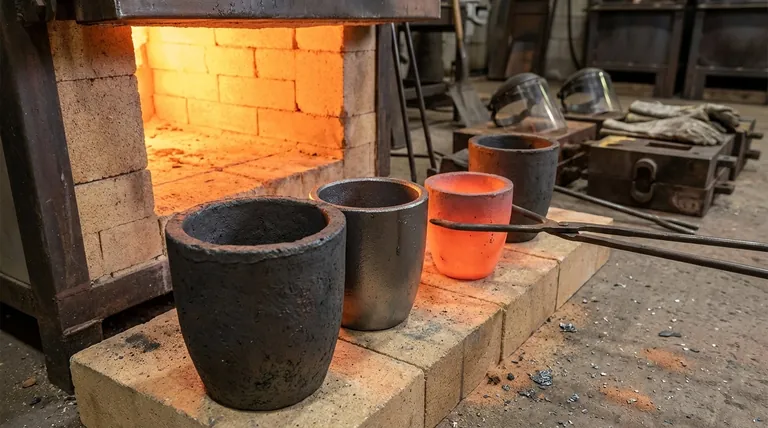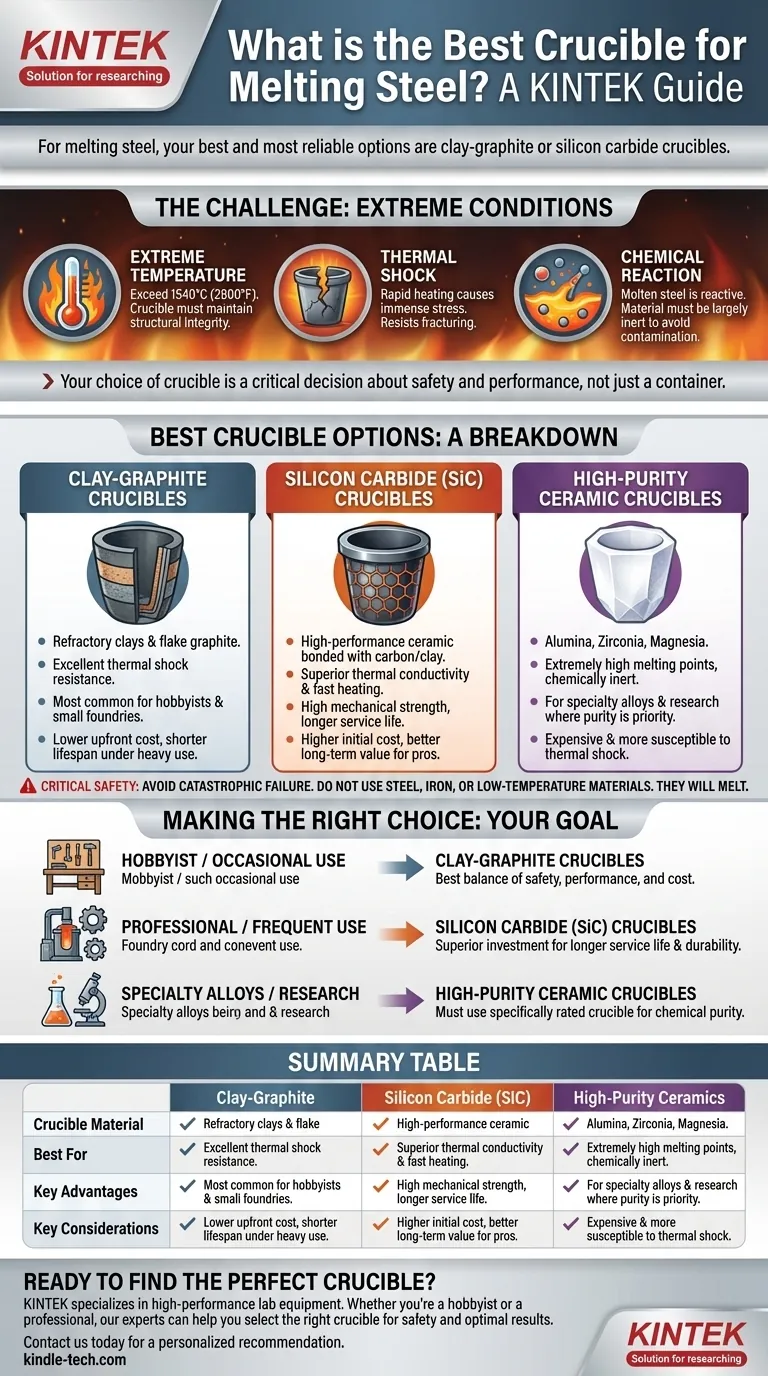For melting steel, your best and most reliable options are clay-graphite or silicon carbide crucibles. While other specialized ceramics exist for laboratory-grade alloys, these two materials provide the necessary high-temperature tolerance, thermal shock resistance, and durability required for the intense heat of molten steel, which melts around 1540°C (2800°F).
The central challenge of melting steel isn't just reaching extreme temperatures; it's containing the molten metal safely in a vessel that can withstand rapid, intense heating without cracking or chemically contaminating the melt. Your choice of crucible is therefore a critical decision about safety and performance, not just a container.

Why Steel is So Demanding
Before selecting a material, it's crucial to understand the extreme environment created when melting steel. This context dictates why only certain materials are suitable.
The Extreme Temperature Requirement
Steel has one of the highest melting points of any common metal. Your crucible must be rated to comfortably exceed 1540°C (2800°F) while retaining its structural integrity.
The Danger of Thermal Shock
A crucible undergoes immense stress when it is heated from room temperature to over a thousand degrees. This rapid temperature change, known as thermal shock, can easily fracture brittle materials.
The Risk of Chemical Reaction
At these temperatures, molten steel is chemically reactive. The crucible material must be largely inert and not excessively leach elements, like carbon, into the melt, which could alter the steel's final properties.
A Breakdown of Viable Crucible Materials
There is no single "best" crucible, only the best fit for your specific furnace, steel type, and budget.
Clay-Graphite Crucibles
These are composite crucibles made from refractory clays (for high-temperature stability) and flake graphite (for thermal conductivity).
They are the most common choice for hobbyists and many small foundries. The graphite content provides excellent resistance to thermal shock, which is a major advantage.
Silicon Carbide (SiC) Crucibles
Silicon carbide is a high-performance ceramic that is bonded with carbon or clay. These crucibles offer superior performance compared to standard clay-graphite.
SiC has exceptional thermal conductivity, meaning it heats up very quickly and evenly. It also has high mechanical strength and excellent durability, leading to a longer service life.
High-Purity Ceramic Crucibles
For highly specialized applications where purity is the absolute priority, crucibles made of pure ceramics are used. These are not common for general-purpose steel melting.
Materials like alumina, zirconia, and magnesia offer extremely high melting points and are chemically inert, preventing any contamination of sensitive alloys. However, they are significantly more expensive and can be more susceptible to thermal shock than composite crucibles.
Understanding the Trade-offs and Critical Safety
Choosing the wrong crucible is not just inefficient; it is extremely dangerous. A failure at temperature can lead to a catastrophic spill of molten metal.
The Cost vs. Lifespan Balance
A clay-graphite crucible offers the lowest upfront cost, making it ideal for those starting out. However, a silicon carbide crucible, while more expensive initially, will typically last much longer under heavy use, providing better long-term value for a professional shop.
The Critical Mistake to Avoid
You absolutely cannot use a crucible made of steel, iron, or any other low-temperature material. It is a common beginner's misconception that a steel can could be used. The crucible will melt along with its contents, causing a complete failure.
The Importance of Proper Handling
Always pre-heat (temper) a new crucible on its first use by heating it slowly and gently to drive out any residual moisture, which could cause it to crack. Inspect your crucible for any cracks or damage before every single use. A compromised crucible should never be used.
Making the Right Choice for Your Goal
Your decision should be guided by your application, budget, and the level of performance you require.
- If your primary focus is hobby-level casting or occasional use: A high-quality clay-graphite crucible is your most practical choice, offering the best balance of safety, performance, and cost.
- If your primary focus is professional, frequent, or high-volume melting: A silicon carbide (SiC) crucible is the superior investment due to its longer service life and greater durability.
- If your primary focus is melting specialty alloys or research: You must use a high-purity ceramic crucible (like alumina or zirconia) specifically rated for your target alloy to ensure chemical purity.
Choosing the correct crucible is the foundation of a safe and successful steel melt.
Summary Table:
| Crucible Material | Best For | Key Advantages | Key Considerations |
|---|---|---|---|
| Clay-Graphite | Hobbyists, Occasional Use | Excellent thermal shock resistance, cost-effective | Shorter lifespan under heavy use |
| Silicon Carbide (SiC) | Professional, Frequent Use | Superior durability, fast & even heating, long service life | Higher initial cost |
| High-Purity Ceramics (Alumina, Zirconia) | Specialty Alloys, Research | Maximum chemical purity, inert | Expensive, more susceptible to thermal shock |
Ready to find the perfect crucible for your steel melting needs?
At KINTEK, we specialize in high-performance lab equipment and consumables, including a full range of crucibles designed for extreme temperatures and demanding applications. Whether you're a hobbyist or a professional, our experts can help you select the right crucible to ensure safety, efficiency, and optimal results.
Contact us today for a personalized recommendation and see how KINTEK can support your laboratory's success!
Visual Guide

Related Products
- Custom Machined and Molded PTFE Teflon Parts Manufacturer with PTFE Crucible and Lid
- High Purity Pure Graphite Crucible for Electron Beam Evaporation
- High Purity Pure Graphite Crucible for Evaporation
- Engineering Advanced Fine Ceramics Alumina Al2O3 Crucible With Lid Cylindrical Laboratory Crucible
- Engineering Advanced Fine Ceramics Alumina Crucibles (Al2O3) for Thermal Analysis TGA DTA
People Also Ask
- How do you clean a melting crucible? Protect Your Crucible and Ensure Metal Purity
- Is a crucible a lab equipment? A Guide to High-Temperature Containers for Labs and Foundries
- Why do crucibles not melt? The Science of Refractory Materials for High-Temperature Use
- What are crucibles used for in lab? Ensuring Accurate, High-Temperature Sample Analysis
- What is the best type of crucible? The Answer Depends on Your Application's Needs



















